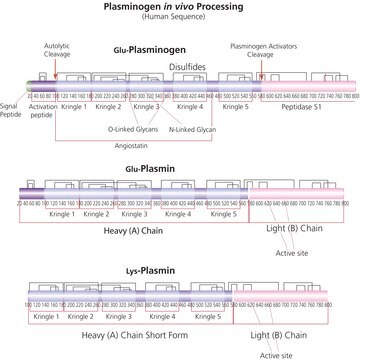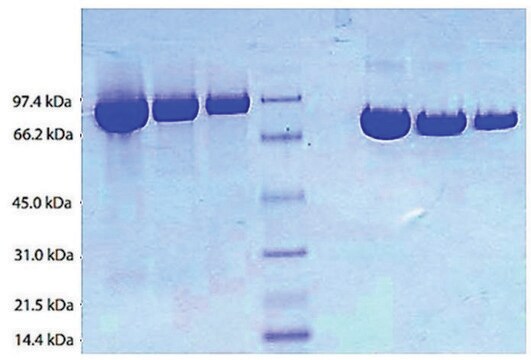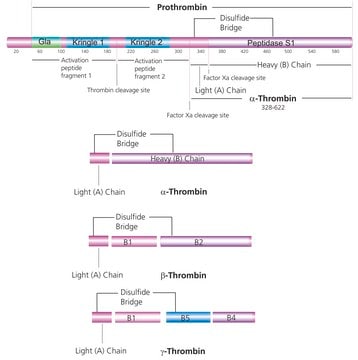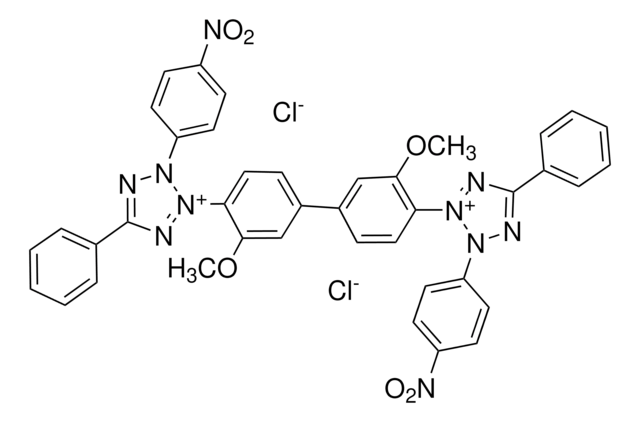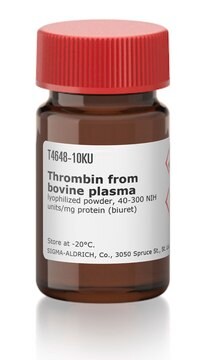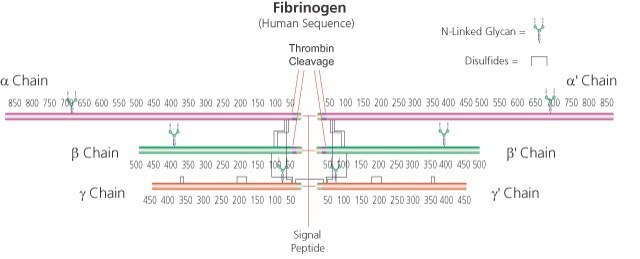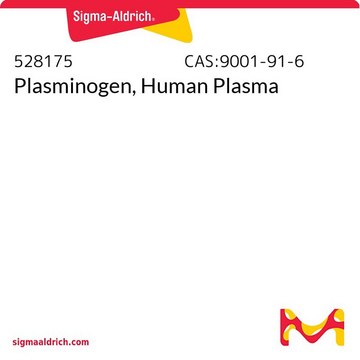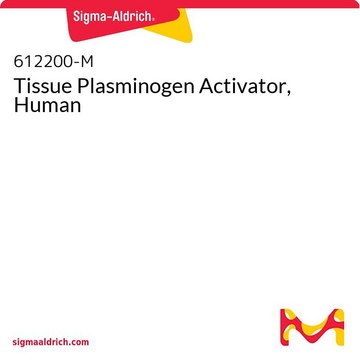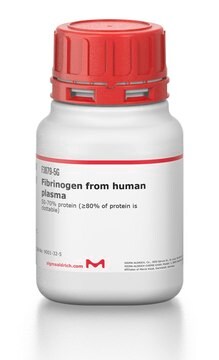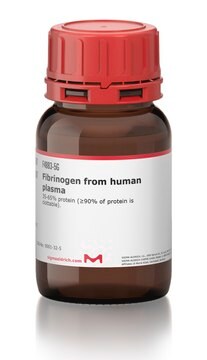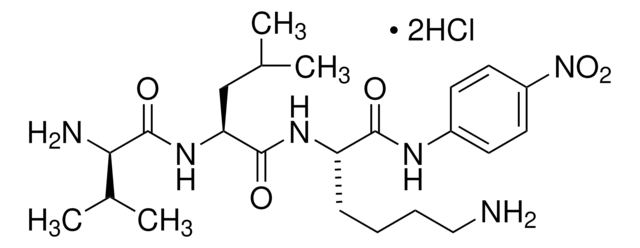P7999
Plasminogen from human plasma
≥2.0 units/mg protein, lumps and powder, suitable for streptokinase determination by clot formation procedure
Sinônimo(s):
Profibrinolysin
Faça loginpara ver os preços organizacionais e de contrato
About This Item
Número CAS:
Número CE:
Número MDL:
Código UNSPSC:
12352204
eCl@ss:
42030240
NACRES:
NA.54
Produtos recomendados
fonte biológica
human plasma
Formulário
lumps and powder
atividade específica
≥2.0 units/mg protein
peso molecular
90 kDa
composição
protein, 2.0-7.0%
adequação
suitable for streptokinase determination by clot formation procedure
nº de adesão UniProt
atividade externa
plasmin ≤0.5% of base activity
temperatura de armazenamento
2-8°C
Informações sobre genes
human ... PLG(5340)
Procurando produtos similares? Visita Guia de comparação de produtos
Descrição geral
The plasminogen (PLG) gene is mapped to human chromosome 6q26. Plasminogen protein has a molecular weight of ?90kDa. It is composed of Pan-apple domain at the N-terminal, five kringle domains and serine protease domain at its C-terminal.
Aplicação
Plasminogen is a single-chain glycoprotein found in human plasma and extracellular fluid. Certain activators, such as tissue plasminogen activator (tPA), convert plasminogen to its active form, plasmin. Plasminogen has been used to study its conversion into plasmin.
The enzyme from Sigma has been used to examine the ability of plasminogen in nasal secretion to promote S. aureus surface colonization. It has been used to assess the binding of recombinant OspC protein to plasminogen using enzyme-linked immunosorbent assay. It has also been used to screen FITC-labeled S. pneumoniae for protein interaction by solid-phase assay. In this assay; a well was coated with plasminogen and incubated with FITC-labeled bacteria.The fluorescence signal was read in a fluorimeter.
Ações bioquímicas/fisiológicas
Plasminogen is the inactive precursor of the protease plasmin. Plasminogen is activated by the action of either tissue plasminogen activator (tPA), which primarily activates the fibrinolytic (thrombolytic) activity of plasmin, or urokinase plasminogen activator (uPA), which is associated with extracellular matrix remodeling and cell migration. Plasmin cleaves fibrin/fibrinogen and blood coagulation factors V/Va and VIII/VIIIa. It activates matrix metalloproteinases by cleaving the inactive proenzymes. It is also involved in the activation of some growth factors, such as vascular endothelial growth factor (VEGF) and transforming growth factor β (TGF-β).
propriedades físicas
Native-intact human plasminogen is a 791 amino acid glyco-protein with as many as 24 disulfide bonds. Plasminogen contains a single N-linked sialylated biantennary glycan. The two O-glycans possess a Gal β-1-3GalNAc core which are α-2-3 sialylated at the terminal Gal. An additional disialylated form has a second sialic acid residue with an α-2-6 linkage to GalNAc. Mono- and disialylated forms occur at a molar ratio of 80:20 in human plasminogen.
Definição da unidade
One unit will produce one micromole of p-Nitroanilide from D-Val-Leu-Lys-p-Nitroanilide per minute at pH 7.5 at 37 °C. Activity is determined after activation to plasmin with urokinase.
Reconstituição
Solutions should be stored in buffer containing 20 mM lysine at neutral pH. The protein should be as concentrated as possible. Frozen in aliquots at −20 °C, it should be stable for several weeks.
Nota de análise
ε-Aminocaproic acid free
Plasma from each donor has been tested and found negative for antibody to HIV-1/HIV-2, antibody to HCV and HbSAg.
Exoneração de responsabilidade
RESEARCH USE ONLY. This product is regulated in France when intended to be used for scientific purposes, including for import and export activities (Article L 1211-1 paragraph 2 of the Public Health Code). The purchaser (i.e. enduser) is required to obtain an import authorization from the France Ministry of Research referred in the Article L1245-5-1 II. of Public Health Code. By ordering this product, you are confirming that you have obtained the proper import authorization.
Código de classe de armazenamento
11 - Combustible Solids
Classe de risco de água (WGK)
WGK 3
Ponto de fulgor (°F)
Not applicable
Ponto de fulgor (°C)
Not applicable
Equipamento de proteção individual
Eyeshields, Gloves, type N95 (US)
Escolha uma das versões mais recentes:
Já possui este produto?
Encontre a documentação dos produtos que você adquiriu recentemente na biblioteca de documentos.
Os clientes também visualizaram
Christopher G Earnhart et al.
Clinical and vaccine immunology : CVI, 18(6), 901-906 (2011-04-29)
Borrelia burgdorferi OspC is an outer membrane lipoprotein required for the establishment of infection in mammals. Due to its universal distribution among B. burgdorferi sensu lato strains and high antigenicity, it is being explored for the development of a next-generation
Genetic risk factors for portopulmonary hypertension in patients with advanced liver disease
Roberts KE, et al.
American Journal of Respiratory and Critical Care Medicine, 179(9), 835-842 (2009)
Jian Sha et al.
Journal of bacteriology, 191(9), 3095-3107 (2009-03-10)
In this study, we demonstrated that the surface-expressed enolase from diarrheal isolate SSU of Aeromonas hydrophila bound to human plasminogen and facilitated the latter's tissue-type plasminogen activator-mediated activation to plasmin. The bacterial surface-bound plasmin was more resistant to the action
Yan Wang et al.
Journal of cellular and molecular medicine, 24(16), 9255-9266 (2020-07-07)
Blood-brain barrier (BBB) integrity injury within the thrombolytic time window is becoming a critical target to reduce haemorrhage transformation (HT). We have previously reported that BBB damage was initially damaged in non-infarcted striatum after acute ischaemia stroke. However, the underlying
Characterization of a reduced form of plasma plasminogen as the precursor for angiostatin formation.
Diego Butera et al.
The Journal of biological chemistry, 289(5), 2992-3000 (2013-12-18)
Plasma plasminogen is the precursor of the tumor angiogenesis inhibitor, angiostatin. Generation of angiostatin in blood involves activation of plasminogen to the serine protease plasmin and facilitated cleavage of two disulfide bonds and up to three peptide bonds in the
Nossa equipe de cientistas tem experiência em todas as áreas de pesquisa, incluindo Life Sciences, ciência de materiais, síntese química, cromatografia, química analítica e muitas outras.
Entre em contato com a assistência técnica